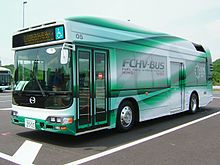Hino Jidōsha
| Hino Jidōsha
|
|
|---|---|
| legal form | Kabushiki-gaisha ( joint stock company ) |
| ISIN | JP3304200003 |
| founding | 1942 |
| Seat | Hino |
| management | Shoji Kondo |
| Number of employees | 9,980 (as of March 31, 2007) |
| Branch | vehicle construction |
| Website | www.hino-global.com/ |
Hino Motors KK ( Japanese 日野自動車株式会社 , Hino Motors Kabushiki-gaisha , English Hino Motors, Ltd. ), listed on the stock index Nikkei 225 , is a Japanese manufacturer of diesel - trucks , buses and other vehicles based in Hino (Tokyo) . Hino is part of the Toyota Group.
history

Automobile Industry Co. Ltd. as the automotive division of Tōkyō Gas and Kyodo Kokusan KK merged in 1937 to form Tokyo Automobile Industry Co. Ltd. together. In 1941 the company name changed to Diesel Motor Industry Co. Ltd. In 1942 the plant in Hino was split off and Hino Heavy Industry Co. Ltd. called. This is the year Hino was founded. At first, trucks and military vehicles were created . The production program was expanded to include buses and for a number of years cars were also produced. The first car was a right-hand drive Renault 4CV built under license , which was built from 1953.
In 1966, Hino and Toyota began working closely together . Now Hino focused on building medium and heavy trucks and buses.
2001 Toyota had 50.46% shares in Hino, making Hino a subsidiary of Toyota.
Products
truck
buses
- RE / RC
- poncho
- Liesse & Liesse II
- Blue Ribbon & Blue Ribbon II
- Rainbow & Rainbow II
- Melpha
- S'elega
- Grand View
- Front-engine chassis (e.g .: FB)
- Front-engine chassis (AK)
- Rear-engine chassis (RG, RM, RK)
Passenger cars
Between 1953 and 1966, Hino Motors also manufactured passenger cars. Initially, this was the licensed Hino-Renault 4CV .
From 1961 models of our own construction were offered. The Hino Contessa 900 , a four-door sedan, had a four-cylinder in - line engine with 893 cm³ displacement and 25.7 kW (35 hp) in the rear. The body was equipped with small tail fins. It was accompanied by a two-door coupé, the Hino Contessa 900 Sprint . Its engine had 33 kW (45 PS), i.e. 10 PS more, and the body was designed by the Italian designer Michelotti . Both vehicles were only offered in Japan.
The body of the second series, which was manufactured as the four-door Hino Contessa 1300 sedan from 1964, was also designed by Michelotti. It was similar to the contemporary English Triumph 2000 and 1300 , which were also from Michelotti; there was also a two-door coupe again. They stayed with the rear engine, now with 1.3 liter displacement. These models were also made in the USA and some European countries, e.g. B. Switzerland and Belgium.
With the participation of Toyota in 1966, the car production at Hino Motors was stopped. From 1966 to 1968 the Hino Contessa was still assembled in New Zealand in a predecessor company of Toyota New Zealand .
Other vehicles
Between 1961 and 1966 there was the Briska , a pick-up and delivery van with the Contessa engine installed in the front.
Dakar Rally
In 1997 the two Austrians Peter Reif and Johann Deinhofer won the truck classification of the Dakar Rally on a Hino Ranger.
literature
- Joachim Kuch: Cars from Japan 1965–1985. Schrader-Motor-Chronik, Schrader-Verlag, Stuttgart 2000, ISBN 3-613-87198-X .
Web links
Individual evidence
- ↑ a b c Information from Hino (English, accessed April 9, 2016)
- ↑ 1967 Hino Contessa 1300 - Rear Guard Assault - 176 ( Memento from November 4, 2013 in the Internet Archive )
- ↑ History of Dakar - RETROSPECTIVE 1979-2007 (PDF) Dakar. Archived from the original on July 8, 2011. Retrieved January 7, 2009.














